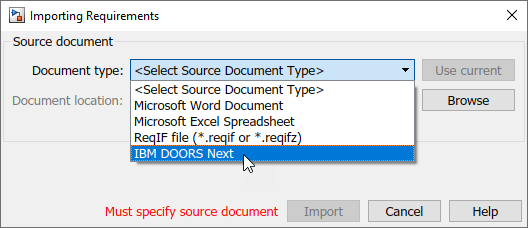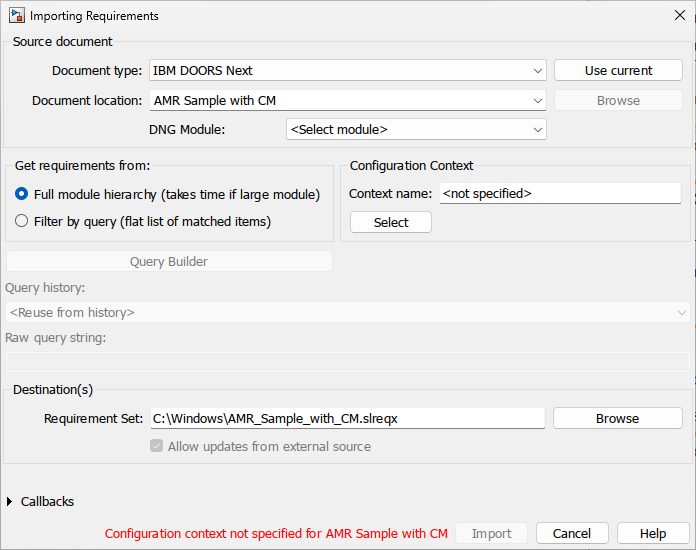从 IBM DOORS Next 导入需求
您可以在 IBM® DOORS® Next 中管理需求,并将整个需求模块或与查询匹配的需求导入 Requirements Toolbox™。Requirements Toolbox 将需求导入为 slreq.Reference 对象,也称为引用需求。在与导入的引用需求建立链接之后,您可以使用需求编辑器或需求视角从导入的引用需求导航到 DOORS Next 中的原始需求。您还可以衡量需求对实现状态、验证状态和变更跟踪的贡献。有关详细信息,请参阅:
注意
在从 IBM DOORS 导入需求之前,您必须先配置 IBM DOORS 接下来会话.有关详细信息,请参阅 配置 IBM DOORS Next 会话。
导入 DOORS Next 需求
您可以通过选择 DOORS Next 模块或创建查询来导入需求。因为 Requirements Toolbox 将需求作为 slreq.Reference 对象导入,所以您必须将需求导入到新的需求集。您无法将需求中的图像从 DOORS 导入至 Requirements Toolbox。
当您从 IBM DOORS 导入需求时接下来,Requirements Toolbox 会根据外部类型设置 Type 属性:
IBM DOORS Next 需求类型 | Requirements Toolbox 需求类型 |
|---|---|
Heading | Container |
Information | Informational |
Diagrams and sketches | Informational |
所有其他类型 | Functional |
有关详细信息,请参阅需求类型。
此外,Requirements Toolbox 禁用没有外部类型 Heading 的需求的索引编号。有关详细信息,请参阅自定义需求索引编号。
当您从已启用配置管理的 DOORS Next 工程导入需求时,您必须在导入之前为您的 MATLAB® 会话选择配置上下文。导入的需求内容和配置是对应的。有关在 DOORS Next 中启用配置管理的更多信息,请参阅 IBM 网站上的 RM 应用程序中的配置管理。有关配置 MATLAB 会话的更多信息,请参阅 slreq.dngConfigure。
您可以通过选择需求编辑器中的导入节点来查看已导入需求的配置上下文。需求编辑器在右侧窗格中的属性下的描述选项卡中显示配置上下文。
导入需求模块
当您从 DOORS Next 模块导入需求时,Requirements Toolbox 会导入整个模块。
打开需求编辑器:
slreq.editor
在需求编辑器中,点击导入。
在导入需求对话框中,将文档类型设置为 IBM DOORS Next。

将文档位置设置为您想要处理的工程。
在获取需求下,选择完整的模块层次结构(如果模块很大,需要时间)。等待 DNG 模块列表填充。

在配置上下文部分中,点击选择以显示选择配置流或更改集列表中的配置上下文。从列表中选择所需的配置上下文。或者,您可以在上下文名称字段中输入配置上下文名称或 URL。
提示
为了节省时间,请在上下文名称字段中输入 URL,而不是输入上下文名称或使用选择按钮。
从 DNG 模块列表中选择所需的模块。
输入需求集的名称和文件路径。您可以点击浏览来浏览保存位置。
点击导入并等待数据从服务器导入到 Requirements Toolbox。导入完成后,需求编辑器会显示导入项的层次结构。
使用查询导入需求
输入以下内容打开需求编辑器:
slreq.editor
在需求编辑器中,点击导入。
在导入需求对话框中,将文档类型设置为 IBM DOORS Next。

将文档位置设置为您想要处理的工程。
在获取需求下,选择按查询过滤(匹配项的扁平列表)。
点击查询生成器打开 OSLC 查询生成器对话框并指定您的查询。使用对象类型旁边的下拉菜单选择要导入的对象类型。
例如,您可以通过将下拉菜单设置为
Is A和Stakeholder Requirement来仅导入利益相关者需求。
要使用其他查询参数创建查询,点击添加过滤器。
注意
如果仅为给定类型的对象定义属性,则必须将对象类型设置为该对象类型,然后才可以通过该属性进行过滤。
完成查询后,点击添加到查询,然后点击确定。在导入需求对话框中,原始查询字符串被填充。
输入需求集的名称和文件路径。您可以点击浏览来浏览保存位置。
点击导入并等待数据从服务器导入到 Requirements Toolbox。
更新引用需求
如果在将需求导入 Requirements Toolbox 后在 DOORS Next 中更新需求,则可以更新需求集以反映更改。在需求编辑器中,选择顶部的导入节点,然后在右侧窗格中的需求交换下点击重新导入模块或重新运行查询,具体取决于您最初执行的导入类型。

软件未提示有来自 IBM DOORS 的可用更新,需在 Requirements Toolbox 中进行更新。
如果更新更改或删除了具有链接的引用需求,则链接存在更改问题。有关详细信息,请参阅跟踪需求链接的变更。
提示
重新导入大型模块可能需要一些时间。如果您知道 DOORS Next 服务器上哪些需求发生了变化,您可以在需求编辑器中选择该引用的需求,然后在右侧窗格中的属性下点击从服务器更新以更新该单个需求。
如果您的 DOORS Next 工程启用了配置管理,并且您在配置 MATLAB 会话时选择了配置上下文,则 DOORS Next 需求将从配置上下文中更新。
从引用需求导航至 DOORS Next 中的需求
您可以使用需求编辑器从引用的需求导航到 DOORS Next 中的原始需求。在需求编辑器中选择引用的需求。在右侧窗格中的属性下,点击在文档中显示。
您还可以使用需求视角从导入的引用需求导航到原始需求。在 Simulink® 模型中,导航到 App 选项卡并选择需求管理器。确保选择了 布局 > 需求浏览器。在需求浏览器的视图下拉菜单中,选择。选择一个需求。在属性检查器中的详细信息选项卡中,在属性下,点击在文档中显示。
如果您的 DOORS Next 工程启用了配置管理,并且您在配置 MATLAB 会话时选择了配置上下文,则 DOORS Next 需求将在配置上下文中打开。
与引用需求相链接
从 DOORS 导入需求到 Requirements Toolbox 之后,您可以按照链接其他 slreq.Reference 对象的方式链接这些引用需求。有关详细信息,请参阅创建和存储链接。
您还可以在 DOORS Next 工程中添加反向链接,这样您就可以从 DOORS Next 需求导航到链接到 Requirements Toolbox 中相应引用需求的工程。有关详细信息,请参阅插入和删除反向链接。